Preface: “But all too often, culture is also manipulated by those who believe that the protection of their identity or interests implies rejecting others. Far from uniting people’s, culture is then used- or misused- to separate and divide. Under such conditions, it is hardly surprising that wars would lead to the destruction of monuments, places of worship and works of art numbered among the most precious creations of the human spirit. Some of this destruction is accidental. In other cases, belligerents have used the argument of military necessity to justify the destruction of cultural property. That was the argument advanced by the United States for the shelling of February 1944 of the famous abbey of Monte Cassino, in the heart of the German defense system that was blocking the Allied advance on Rome.
But in most cases, such destruction is deliberate. When monuments, places of worship and works of art are attacked, the aim is to destroy the enemy’s identity, his history, his culture, and his faith, so as to eradicate all traces of his presence and in some cases, his existence.[1]”
The essential system of the International Criminal Court (ICC) adopted In Rome Statute in July 1998, defined war crimes as: “…intentionally directing attacks against buildings dedicated for religion, education, art, science or charitable purposes, historic monuments, hospitals …provided that they are not military objectives.[2]” The ban includes as well committed crimes in international and non-international armed conflicts[3].
In the ongoing Syrian armed conflict, dozens and even hundreds of assaults on places of worship have been documented. This brief report is on incidents that occurred recently in besieged Eastern Ghouta in the Damascus countryside.
First: Bombarding the an-Na’essan Mosque in Duma city, Damascus Countryside:
On April 4, 2017 at about 1:15pm Damascus time, Syrian warplanes conducted a raid on an-Na’essan mosque located in Duma city in Damascus countryside. The field researcher of Syrians for Truth and Justice-STJ said the bombardment coincided the time when dozens of worshippers were performing the Noon Prayer. Several worshippers injured with injuries varying from moderate to severe. In addition to destroying a part of the mosque according to testimonies and images.
Omran Abbas, 17, from Duma city and one of the survivors, said in his testimony that the raid was at the time of performing the prayer and up to 60 people were injured including children. He added,
“I was one of the worshippers; the rescue team gave me medical help after I got wounds in my hands, legs and my head. After the attack, I remained two nights in the hospital.”
Maemoun Qashou’e, another survivor, said in his testimony to Syrians for Truth and Justice:
“Before the rescue team that contains the Civil Defense and the Red Crescent came to rescue us, I saw several worshippers bloodied as the debris of the mosque fell over them. I remember well how the Imam got critical wounds, and I still remember the voice of a child trapped under the rubble close to the door of the mosque.”
The Syrian Civil Defense in Damascus countryside posted a video tape shows rescue operations to the injured worshippers taken from under the rubble including an elderly civilian during the Syrian warplanes shelling of an-Na’essan mosque, April 4, 2017.
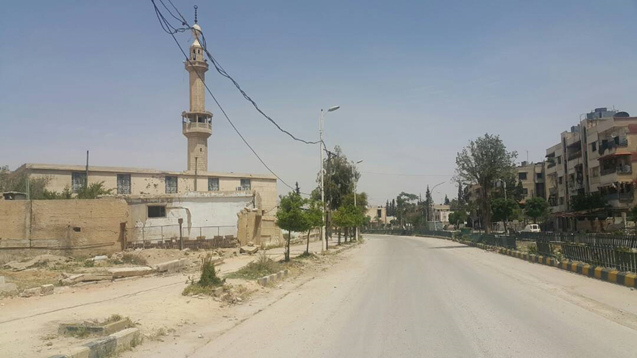
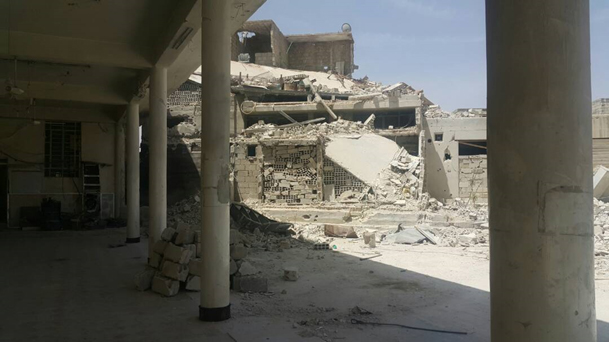
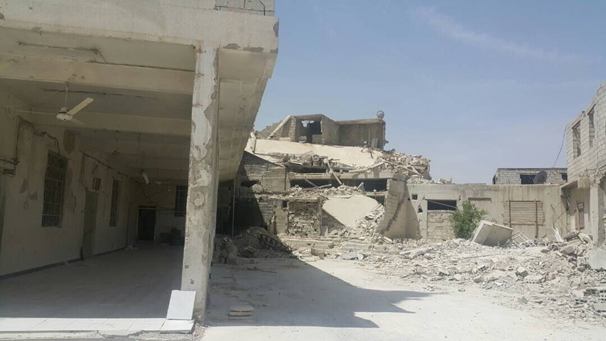
Images explains the damage caused to an-Na’essan mosque, Duma city after the attack by Syrian warplanes. Exclusive photo to Syrians for Truth and Justice.
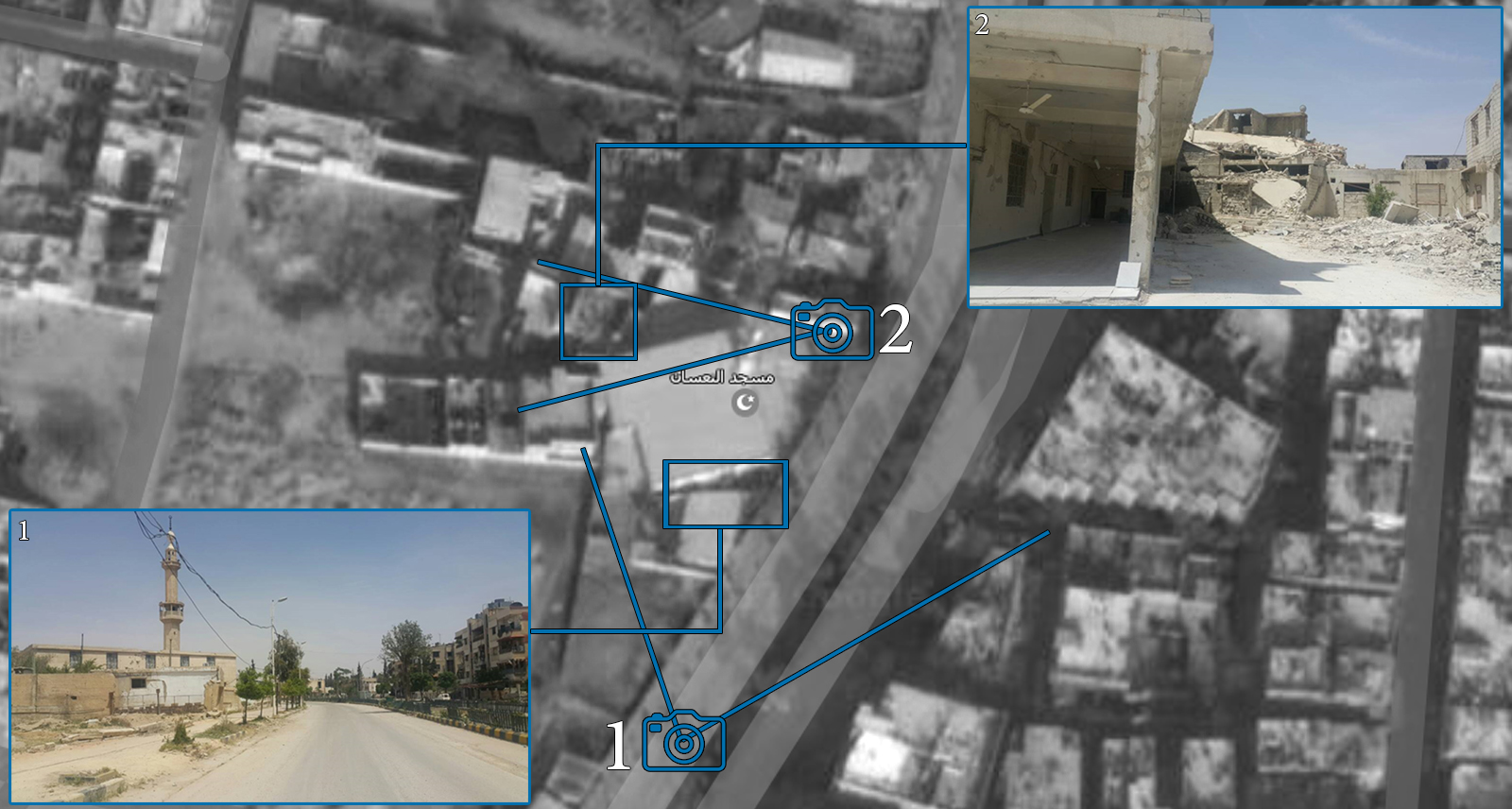
Second, Bombardment on Erbin mosque in Erbin city, Damascus countryside:
Shelling places of worship is repeated generally in cities and towns of Eastern Ghouta by Syrian warplanes. The type and nationality of the aircraft is recognized by “opposition observatories[4]” which monitor the air traffic inside Syrian military airports and circulated it in special rooms within the application of “Telegram”. After that, the news posted to activists and locals to raise the alarm through microphones in mosques distributed in those towns. Streets and roads evacuated fearing of the shelling.
On April 7, 2017, two days after targeting an-Na’essan mosque in Duma, the Erbin mosque in Erbin city, Damascus countryside was also targeted with five thermal rockets, Abo al-Yuser Braa, the Director of Erbin Media Office, confirmed that to Syrians for Truth and Justice. He said:
“An hour after performing the Noon Pray and leaving the mosque for usual business, a warplane launched five Guided rockets (that hit the target accurately), killed a child and wounded many more, and caused a great damage to back of the mosque, as well.”
Syrians for Truth and Justice documented the identity of the dead child as "Souleiman Sheqeran”, he died while was touring the impact location.
The Erbin Media Office in Damascus countryside posted a video tape that showed the destruction caused to Erbin mosque in the Syrian warplanes attacks April 7, 2017.
An image illustrates the damage to the back of Erbin mosque in Damascus countryside, April 7, 2017. Photo exclusive to Syrians for Truth and Justice.
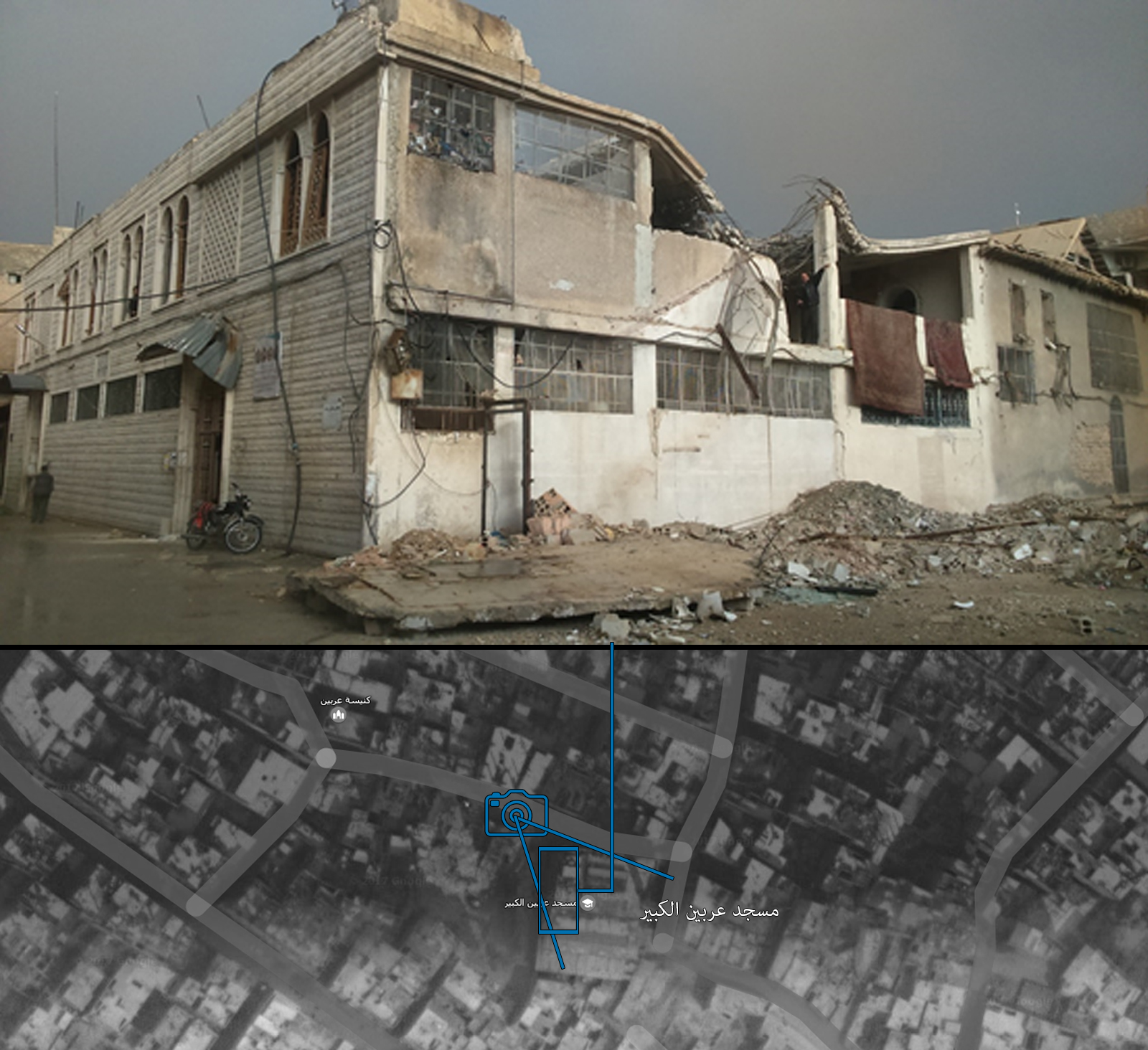
It is worth mentioning that “the Great Mosque of Erbin” lies in the city center in the middle of vegetable market, and goes back to pre- sixteenth century Hijri. It is the first and biggest in size. It is a monument in its construction and architecture and is similar in the decorations and inscriptions to the Great Umayyad Mosque located in Damascus, the capital.
Third, injured people in an indiscriminate bombardment on Kafr Batna mosque, Damascus countryside:
On April 12, 2017, the mosque of Kafr Batna located in Kafr Batna town, Damascus countryside, bombarded with mortar shells during the Noon Prayer at 1:15pm Damascus time. Three worshippers injured, according to Mohamed al-Aghwani’s testimony, a survivor interviewed by Syrians for Truth and justice reporter while touring the site.
Siraj Mahmoud, the official spokesperson the Civil Defense in Damascus countryside, said in his testimony to Syrians for Truth and Justice:
“After inspecting the site by the Civil Defense volunteers, it was clear that the mortar shells did not explode, but fell on three young people were sitting, which caused injuries varied from moderate to minor and demanded immediate medical help.”
Siraj Mahmoud explained that Syrian regular army systematically targets civilian complexes and places of worship, although they do not contain any military headquarters affiliated to armed opposition forces.
He mentioned that Syrian regular army always targets the mosques in Eastern Ghouta with either guided rockets or artillery shells, particularly during the Friday Prayer, as it gets full of worshippers.
In a related subject, several locals from Duma, Erbin, and Kafr Batna located in Damascus countryside, their real names are withheld, confirmed to Syrians for Truth and Justice Reporter that the targeted mosques did not contain any armed opposition headquarters or even near them.
Kafr Batna is one of the oldest mosques in the town; it dates back to the end of the Ottoman era.
An image illustrates the site of a mortar shell inside Kafr Batna mosque April 12, 2017. (Exclusive to Syrians for Truth and Justice).
With the start of combats in late 2012, and early 2013 between armed opposition factions and Syrian regular army to seize towns and cities in Eastern Ghouta, Damascus countryside, the latter retreated due to intensive opposition strikes.
Syrian army and its war guns did not stop targeting mosques especially during the Friday Prayers. This led religious institutions and Fatwa Councils in Eastern Ghouta, Damascus countryside, represented by (the General Sharia Board and the Sharia Board in Damascus countryside) to issue a Fatwa to perform the Friday Prayer ahead to its schedule known by every Muslims given that the largest number of worshipers gather at that time. Consequently, each mosque performs the Noon Prayer in different times in order to miss the regime, as much as possible, the opportunity to target the population in gatherings to perform religious rites, Syrians for Truth and Justice Reporter said.
[1]The origins and development of legal protection of cultural property in the event of armed conflict in the International Humanitarian Customary Convention Framework, Franҁois Bognion, the 50th anniversary of the 1954 Hague Convention available on
https://www.icrc.org/ara/resources/documents/misc/5xff7b.htm
[2] The Rome Statute of the International Criminal Court on July 17, 1988, article 2, 8 b and 8, 2
[3] The Magazine of the International Red Cross, number 832, December 1998, the pages 743, 737
[4] Some defectors of the Syrian regular army along with other people do the monitoring. They have wireless devices enable them to know the time and destination of aircrafts thus facilitating evacuation of population and mitigate large numbers of casualties at the time of shelling.

